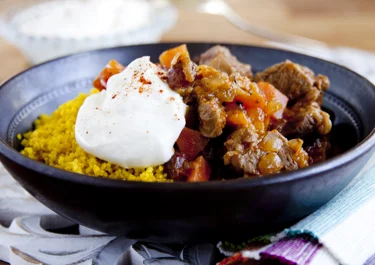Tagine

This tagine is a North African lamb stew that is at its best when cooked in an earthenware pot. Feel free to add the dried fruit towards the end of the slow cook so that it doesn't boil away.
Ingredients
|
500 g
Diced lamb (shoulder, leg or neck fillet)
|
|
|---|---|
|
200 g
Celeriac
|
|
|
150 g
Carrots
|
|
|
1
Yellow onion
|
|
|
2
Cloves of garlic
|
|
|
½
Fresh red chilli
|
|
|
1 tbsp
Butter & rapeseed oil
|
|
|
1½ tsp
Salt
|
|
|
½ tsp
Black pepper
|
|
|
2
Cinnamon sticks
|
|
|
½ tsp
Ground cardamom
|
|
|
½ tsp
Ground coriander
|
|
|
2 tbsp
Tomato paste
|
|
|
500 ml
Water
|
|
|
100 g
Apricots
|
|
|
75 g
Raisins
|
To serve:
|
200 ml
Natural yoghurt
|
|
|---|---|
|
200 ml
Couscous
|
Instructions
Recommended information
Serving suggestion
Tagine
Do you put water in the top of a tagine?
No, the hole at the top of the cone-shaped lid is to release steam during the cooking process. Water (or broth) is typically added to the bottom of the pot as the last step of the recipe.
How do you stop a tagine from cracking?
The trick is twofold. First, make sure you soak your pot well in advance (minimum two hours, ideally 24 hours before use). The second trick is to never expose it to high heat or sudden changes in temperature. Keep your burner setting low or, if you’ll be using an oven, stick to temperatures below 160° C. Also avoid adding cold liquids or ingredients to a hot tagine and vice versa.
How hot should my oven be?
The best temperate is 160° C or lower. Remember to always place your cold pot in a cold oven (and vice versa) to ensure gradual heating and prevent it from cracking.
Do you have to soak a tagine every time you use it?
The short answer is yes. Minimum soaking time for both glazed and unglazed clay pots is two hours before use but should ideally be extended to a full 24 hours.
A melt-in-your-mouth stew packed with flavour
Dating as far back as the eighth century, the tagine is a comfort food favourite that has stood the test of time. Traditionally cooked in an earthenware pot, it produces melt-in-your-mouth stews that are perfect for those cold winter nights, rainy days and everything in between.
A hot and tasty North African stew
Few things warm you from head to toe like a beautifully fragrant stew, especially those that have been passed down from generation to generation like the once humble tagine from North Africa. Traditionally including meat as the star of the show, vegetarian and fish options are becoming equally popular alternatives.
The different varieties of tagine
Glazed or unglazed? Aluminium or cast iron? They come in many shapes and sizes and, while there isn’t a right or wrong, your experience level will most likely be the deciding factor.
- Beginners: A cast iron option is a great place to start. They don’t crack, won’t burn as easily as clay varieties and are also the most versatile and durable.
- Intermediate: If your tagine game is a bit more advanced, a glazed clay pot is for you. They are less prone to cracking and burning while still giving you that traditional feel.
- Experienced: Unglazed clay pots are one of the trickiest styles to use but oh so worth it from a flavour perspective. As the porous clay soaks up every dish, your pot will soon become its very own secret ingredient that will be impossible to replicate.
The magic of clay pot cooking
Clay pot cooking is renowned for creating intensely flavourful dishes that only get better over time. Because the porous material soaks up a bit of every dish, the pot eventually adds a distinct flavour profile to every meal. Combined with it being a relatively low-effort and versatile way of cooking, it’s little wonder that the earthenware tradition is making a comeback.


&format=webp)




&format=webp)

